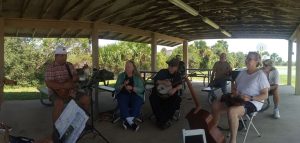
To include your event in the Briefing and Live Calendar, please fill out this form.
Weather: Mostly sunny. Highs in the mid 70s. Northeast winds 10 to 15 mph. Friday Night: Partly cloudy. Lows in the upper 60s. Northeast winds 10 to 15 mph.
- Daily weather briefing from the National Weather Service in Jacksonville here.
- Drought conditions here. (What is the Keetch-Byram drought index?).
- Check today’s tides in Daytona Beach (a few minutes off from Flagler Beach) here.
- Tropical cyclone activity here, and even more details here.
Today at a Glance:
Free For All Fridays with Host David Ayres, an hour-long public affairs radio show featuring local newsmakers, personalities, public health updates and the occasional surprise guest, starts a little after 9 a.m. after FlaglerLive Editor Pierre Tristam’s Reality Check. Today: a face-off between Palm Coast mayoral candidates Cornelia Manfre and Mike Norris. See previous podcasts here. On WNZF at 94.9 FM and 1550 AM.
Flagler and Florida Unemployment Numbers Released: The state’s Commerce Department released the previous month’s preliminary unemployment numbers for Florida and its 67 counties, at 10 a.m. See the data releases page here.
The Blue 24 Forum, a discussion group organized by local Democrats, meets at 12:15 p.m. at the Palm Coast Community Center, 305 Palm Coast Parkway NE. Come and add your voice to local, state and national political issues.
Wandering Spiral Performs at The Gathering Place, 7 to 9 p.m. Oct. 18 at The Gathering Place, 204 Moody Blvd., Flagler Beach. The music duo Wandering Spiral, featuring Michelle Davidson and Rick de Yampert, FlaglerLive’s arts and culture writer, will perform original East-West fusion, Buddha lounge and trance soundscapes on sitar, Native American flutes, metal and wooden tongue drums, crystal and Tibetan singing bowls, digital tabla, tribal percussion and ethereal synth. Heather Hodovance will guide participants through opening and closing meditations and intention setting. Cost is $20. For more information or to purchase tickets in advance, go online at gatheringplace.events or call 386-338-3227. More details here.
Readings: Robert Caro is the now-88-year-old Hercules racing the clock to finish the fifth and final volume of his biography of LBJ, a Decline and Fall for our time, in quality and subject. I am not exaggerating. Caro is an even better and more judicious, if not more objective, investigator than Gibbon was, and his prose, while not classically ornate as Gibbon’s, gains strength from its American purity and directness. It is a prose of immense power writing the biography of power. Caro’s first book though was The Power Broker: Robert Moses and the Fall of New York, the biography of one of the most imperious Americans of the last hundred years, the man who remade New York City in his image, demolishing swaths of it along the way, plundering old communities for his misguided notions of urban renewal, and tyrannizing over the city, over mayors and governors and populace, without ever having held an elected office. The book is 1,162 pages before the notes. It is a page-turner. I can boast: I have read it twice and will happily read it again, if only for the prose and the technique on display, though there’s so much more. It’s an immersive history of New York and its times (and The New York Times’s habit of licking Mose’s boots though most of New York’s power class did). A little while back the Times, converted to Caro’s version of Moses, ran a couple of pieces about Caro and the book’s 50th anniversary, a book that’s never been out of print. “Moses, in Caro’s telling, was nearly as autocratic and cultishly revered as Mao, all but unchallenged as he went about imprinting his ideas of urban improvement on the seat of the American imperium,” the paper reports. “Even the haughty [Gore] Vidal succumbed to Caro’s spell. It had taken him, he admitted, a full month to read “The Power Broker”’s more than 1,200 pages, but “not once — uniquely — did I find myself glumly rifling the pages still to be read at the back.” One reason is the story Caro tells. Another is his seductive prose, the iterative sentences as thickly cabled as Moses’s bridges, the incremental building of phrase upon phrase, of clause piled upon clause, all held together by the urgent rhythms of Caro’s voice.” A separate piece reveals to what extent Caro’s editor, great though he was (Robert Gottlieb at Knopf), butchered the book: “The original draft of “The Power Broker” totaled more than a million words, far too long to print as a single volume. Caro and Gottlieb had to slash 350,000 words — the rough equivalent of two or three average books. Five decades later, Caro still regrets many of the cuts. Squinting through the glass at a manuscript page that was cut from the final version, Caro reread his own lost words. The passages described the loneliness that older women living in the East Tremont neighborhood of the Bronx felt when they were forced from their homes, which were demolished to make way for Moses’s Cross Bronx Expressway. Next to the page was a cocktail napkin that held Caro’s scribbled lines, comparing the women of East Tremont to the characters in the musical “Fiddler on the Roof.” “I thought that was about the best thing I wrote,” Caro said. “A lot of my writing I’m not proud of, but something that you are proud of, to think no one’s ever going to read it, if you want to know the truth, it’s very sad.”” So not for us, a restored version of the complete Power Broker, a study in power that stood as a prelude to the greater study in power that is the LBJ biography. Power, not influence. “Influence?” asked Hans in Katherine Ann Porter’s “The Leaning Tower,” “A purely oblique, feminine, worthless thing, influence. Power, pure power is what counts to a nation or a race. You must be able to tell other peoples what to do, and above all what they may not do, you must be able to enforce every order you give against no matter what opposition, and when you demand anything at all, it must be given you without question. That is the only power, and power is the only thing of any value or importance in this world.” That was Moses, and Moses was nothing compared to LBJ.
—P.T.
View this profile on Instagram
![]()
The Live Calendar is a compendium of local and regional political, civic and cultural events. You can input your own calendar events directly onto the site as you wish them to appear (pending approval of course). To include your event in the Live Calendar, please fill out this form.
December 2025
Flagler Beach United Methodist Church Food Pantry
Rotary’s Fantasy Lights Festival in Palm Coast’s Town Center
Free For All Fridays With Host David Ayres on WNZF
Scenic A1A Pride Meeting
Friday Blue Forum
Acoustic Jam Circle At The Community Center In The Hammock
Rotary’s Fantasy Lights Festival in Palm Coast’s Town Center
For the full calendar, go here.

From the sea New York Harbor was a sight to make authors strain for adjectives. Writers had described the colossal staired and serried mass of towering skyscrapers, which seemed to be rising out of the water, as a giant ship (Melville had been reminded that the very name “skyscraper” had once been used by sailors to describe a sailing ship’s topmost canvas); as a «structure of tiered decks,” pointing at the watcher and “growing taller and taller” like the prow of a furiously onrushing vessel; as a medieval fortress, whose towers, rising out of swirling tides, at night were “blocked by darkness into a sentinelled medieval keep of enormous height and unscalable defense” that might have been inhabited more fittingly by dead kings than recent bankers; as a mesa, a petrified forest, a “giant’s cromlech.” And the very number of the metaphors proved the power of the scene to excite the imagination, proved, in fact, the truth of the one image used most frequently to describe it: that the view of New York from its harbor was one of the wonders of the world. The unique importance of Battery Park to New York City was obvious not from the sea but from the air- from a plane or from the observation platform of the Empire State Building a thousand feet in the sky over Manhattan Island. To the observer looking out over what has been called “the most significant panorama that modern civilization offers,” the buildings in which 12,000,000 persons lived and worked in 1939 seemed to stretch out endlessly to the horizon. But from such vantage points it could be seen that they were not only stretching out but closing in, building up, pressing inward, crowding closer and closer together, until, as if the concentrating inward surge of humanity constituted a geologic force, in the epicenter of that surge the buildings of Manhattan were thrust upward and toward the sky. And it was near the island’s southern tip, the tip jutting into the harbor, that the colossal upthrust had been greatest. In the upper part of Manhattan the masses of concrete were mostly sixty feet high, or seventy; in the center of the island, they were a hundred and fifty or two hundred. But as the island narrowed toward its southern tip, they were four hundred feet high, five hundred, cramming closer and closer together, bulking up higher and higher as they loomed southward pressing inexorably toward the island’s tip–until at the very tip, at the very end of the most crowded island in the world, at the very spot in the entire world in which buildings should have been crowded most closely together, there were suddenly, with the exception of a tiny old fort converted into an aquarium, no buildings at all. At a point at which a single square foot of land was worth thousands of dollars, at which the value of an acre was computed not in the millions of dollars but in the tens of millions, there sat 967,032 square feet of land–22.2 acres–vacant except for grass and trees, pathways between them, benches, and a broad, breezy waterfront promenade.
And it wasn’t from either sea or air that the value of park and harbor was most apparent. It was from the ground, from the nearby streets of the city, from the bleak narrow concrete canyons of Lower Manhattan from which towering masses of concrete and steel had crushed sunlight and sky and green grass and trees and, by hemming between them the swirling concentration of humanity (half a million human beings worked in Manhattan’s single southernmost mile), peace. If there was ever a place in which a man occasionally needed to be alone for a while, to sit in the open, in the sun, among grass and trees, for a minute or two, to escape from crowds and noise, that place was Lower Manhattan. And in all the streets of Lower Manhattan, there was no place to do so. There should, moreover, have been a sense of the sea in Lower Man-hattan, which was, after all, the tip, the seamost tip, of the island that was the world’s largest seaport. But there was no sense of the sea in Lower Manhattan; skyscraper walls blocked that out, too. CnThere was no sense of history, either.
–From Robert Caro’s The Power Broker (1974). .


































Ray W, says
Thank you, Mr. Tristam, for your perspective on power and of its wielding by Robert Moses over the powerless.
On the subject of Florida’s government wielding excessive power, CNN reports that yesterday a federal district judge granted an injunction against Florida’s surgeon general, Dr. Joseph Lapado, MD., “after the state health department threatened to bring criminal charges against broadcasters airing the ad.”
The judge wrote in his order:
“To keep it simple for the state of Florida, it’s the First Amendment, stupid.”
What ad could possibly bring a written threat to criminally prosecute television stations for airing it? And what response by the government to the ad could possibly bring a judge to write that the agency and those who lead it are “stupid”?
The ad contained the spoken account of a mother who had been pregnant with her second child. She was diagnosed with an aggressive form of brain cancer that would kill her if untreated before her child could be born. Without treatment that would certainly kill her fetus, this meant that not only her fetus would die, but that she, too, would die, and that her first child would become motherless.
How could any government possess the political power, much less the wisdom, to make such a choice? Does one potential life end or three lives potentially end? The only possible person who can make this choice is the mother.
The state health department declared the ad “false” and “dangerous” to public health.
General counsel for the state’s health department, John Wilson, sent out the “cease and desist” letters threatening criminal prosecution to multiple television stations it they continued to air the ad. He then resigned his position, stating in his resignation letter to the department that “a man is nothing without his conscience”, adding that “it has become clear in recent days that I cannot join you on the road that lies before the agency.”
For those FlaglerLive readers who do not understand legal ethics, a lawyer who works for a law firm (in this case the State of Florida) must challenge a decision by the law firm that would require him or her to engage in any act that might violate either the law or the rules of professional conduct. The challenge must include the reasons why the act should not be done.
Since the most important aspect of the law is that the law is what a judge says it is on the day he or she says it, and that we must never forget that aspect, then no lawyer ever knows what the law is today. The best any lawyer can say about the law is what it was yesterday. Today can change everything. Witness Roe and Dobbs.
If the firm continues to insist on furthering the potentially illegal act, the lawyer must choose either to follow the firm’s direction and accept whatever consequences flow from following the direction or to resign.
I infer from the sequence of events and the language used that Mr. Wilson protested the initial legal decision to threaten television stations with criminal prosecution, but he was overruled. He then issued the letters but sought guidance from the Florida Bar. After that, he determined that since what he had been ordered to do was in his opinion unlawful, he had no option left to him other than to resign.
Who knows if ever today’s no longer conservative Republican Party will come to the understanding that the only maxim, the only foundation, is for them to accept that the original intent of our founding fathers was that the checks and balances on the exercise of all forms of political power that our founding fathers purposefully inserted into the proposed Constitution is the only way to preserve their experiment in a liberal democratic Constitutional republic. That no one person or political party is ever to gain unlimited political power for an indeterminate period of time, else the experiment fails, and we join in the collapse of every previous effort on record at the time of the founding to establish a stable democracy.
Time and again, today’s Republican leadership proves Wittgenstein right. The most difficult thing in live is to not fool oneself.
Ray W, says
The Cool Down reports that Nio, a Chinese automaker specializing in battery electric vehicles (BEV) now has 2000 automated battery swapping stations throughout China and Europe.
Yes, drivers can charge the car at home, but if a long drive beckons, a Nio owner can drive to one of the stations and pay a little more to put the car through an automated process akin to a car wash where the car is drawn into the station and the battery is swapped out via robotics for a larger fully charged battery.
A Nio owner documented the process. He ordered the swap-out on his cell phone. The car was directed into a building. In a process lasting “minutes”, a 150-kilowatt-hour battery replaced the standard 75-kilowatt-hour battery at a rental cost of $42.46 for two days. After two days, the owner returns the larger battery at any station for a standard smaller battery. The owner then drove 554 miles before the range indicator hit zero.
For purposes of argument, if gasoline costs $3 per gallon, or close to it, then 13 gallons of gas costs $42, or a bit more. That equates to 42.6 mpg. If Nio can make money by providing a occasionally needed service to its owners who are willing to pay for the convenience, then it is a win-win.
Kelley Blue Book reports that American drivers average less than 40 miles per day. The Nio’s standard smaller battery easily covers that distance and much more. But when range greater than that offered by the standard battery is needed, some owners might find it convenient to be able to pay a little more for a lot more range. A company named “Ample” is building a network of swapping stations in California. Roughly one in five personal transport vehicles sold worldwide last year were electric of various types and the conversion to BEV vehicles is growing. Change is coming fast to the industry.
Skibum says
Your comment has reminded me of a very interesting video of the same, or similar battery exchange process that is in place in one of the Scandinavian countries, where an electric vehicle driver pulled his vehicle into what resembled an automatic car wash and the battery was robotically removed and replaced with a new one. At the time I thought it was a permanent battery replacement process for a worn out EV battery. However, after reading your comment above, I’m now wondering if it was the same type of temporary replacement for a longer trip. In any case, the U.S. really needs to ramp up our technology to keep pace with what is going on around the globe, or we will be very far behind the curve real soon.
Pogo says
@Duh MAGA alternative
Sad, and true — welcome to Floriduhstan
https://www.google.com/search?q=coal+rolling